Imagine you are looking to buy a refrigerator, a web cam, or a printer. Odds are you will find many products with very similar features. The question then arises: should you buy whichever one is highest-rated, regardless of the price? Or should you buy whichever one is cheapest, regardless of its quality?
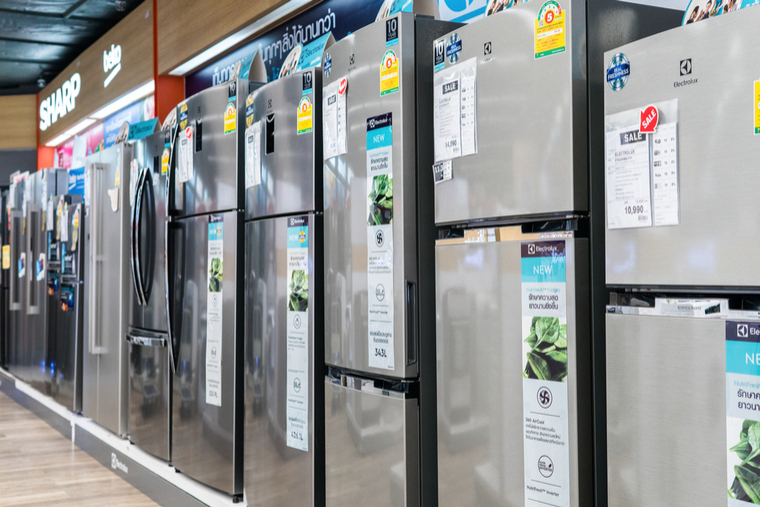
I believe that quality and price are both important. And I’ve developed a method for using both criteria to decide quickly which product to buy when comparing products with similar features.
I’ve used this method to decide which refrigerator, washer, or dryer to buy—“big ticket” items where I didn’t want to make a mistake in terms of money or quality. But because the method is so easy, I’ve also used it to decide between “small ticket” items like web cams, printers, and blenders.
Here’s the method, which you can use to make a great purchase whenever deciding between two or more similar products:
2 Quick Steps on Your Part
Let’s say you want to buy a stainless-steel refrigerator with French doors and an external ice and water dispenser.
You look on HomeDepot.com and find 10 such fridges. Any of the 10 would work for you. But some cost over $3,000. Others cost less than $1,600. Some have a solid, 4.7/5 rating. Others have a weak, 3.8/5 rating. Which should you buy?
Step 1. Grab My Free “Product Decision Tool” Spreadsheet
I’ve created a spreadsheet to help answer that question quickly. Grab it here:
Step 2. Enter the Price and Rating into the “Product Decision Tool”
For however many products you want to compare, enter the name, price, and average user rating for each of the similar products. For example:
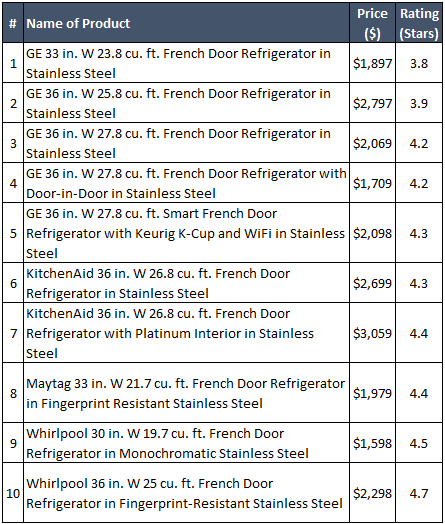
To get the average user rating—whether you’re using a site like HomeDepot.com or Amazon—click on (or hover your mouse over) the stars shown for the product. In the following example, doing so shows an average user rating of 3.8 out of 5:
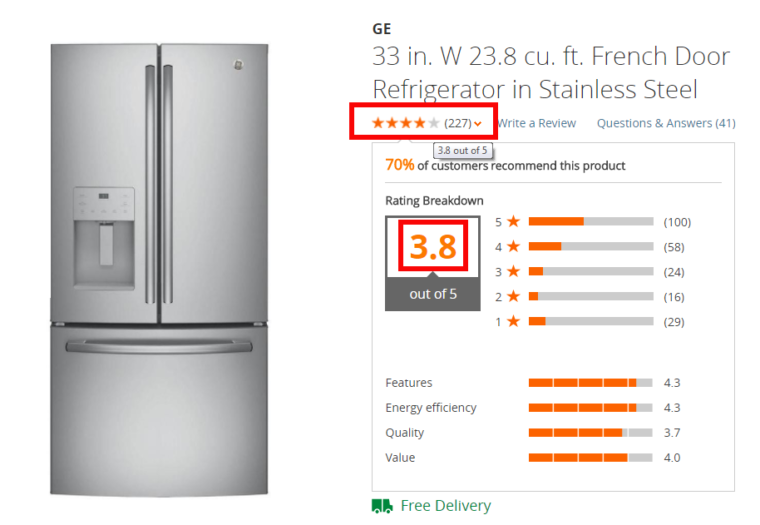
While customer reviews do not perfectly reflect quality, they come pretty close, especially if there are a lot of reviews. If a product has more than 100 customer ratings, you’re probably safe to include it in your consideration as the ratings are probably fairly accurate. I’d certainly exclude any product with fewer than 30 reviews.
The Best Product Considering Quality AND Price
After completing the two above steps, the Product Decision Tool will show you which product is best to buy. Here’s how the spreadsheet works:
Auto-Calculates “Value”
Upon entering the information in Step 2 above, the spreadsheet will auto-calculate each product’s “value.” In this context, “value” is defined as price divided by average user rating. Excel will also auto-color-code the results, with green being good and red being bad:
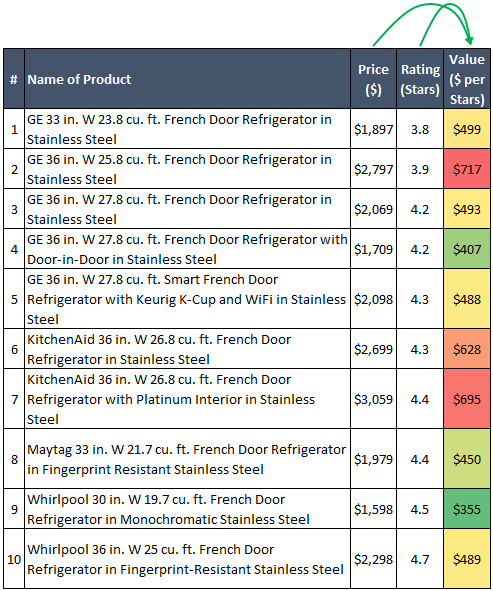
Here’s the reason for this calculation. The price is what the product costs. The average user rating is the best metric we have representing the product’s quality. By dividing the price by the average user rating, we see that some products cost a lot compared to how good they are reported to be. Fridge #2, for instance, costs $717 per its average user rating. It’s expensive for how good it is. Fridge #9, by contrast, only costs $355 per average user rating. It’s inexpensive for how good it is.
Honestly, if that were the only calculation you performed, you’d end up making a solid purchase most of the time.
But wait, there’s more!
Auto-Calculates “Ranks”
The spreadsheet then ranks the products in terms of price, average user rating, and value, respectively. And it color-codes the ranks:
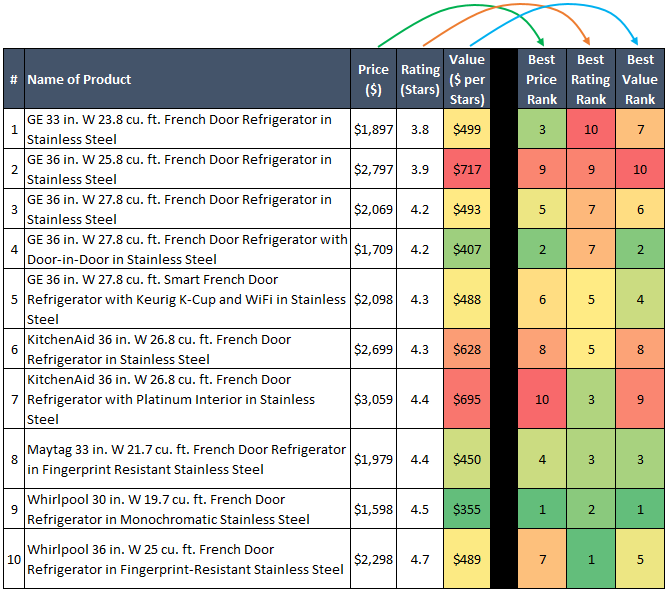
The color-coded ranks allow you quickly to make certain observations. For instance, Fridge #10, while ranked #1 for average user rating, is ranked #7 for price and #5 for value. So, despite it’s great average user rating, Fridge #10 is somewhat of a mixed bag.
Auto-Calculate the Average of Ranks
And finally, in Column K, the spreadsheet calculates the average of each product’s Price Rank, Rating Rank, and Value Rank (with color-coded results):
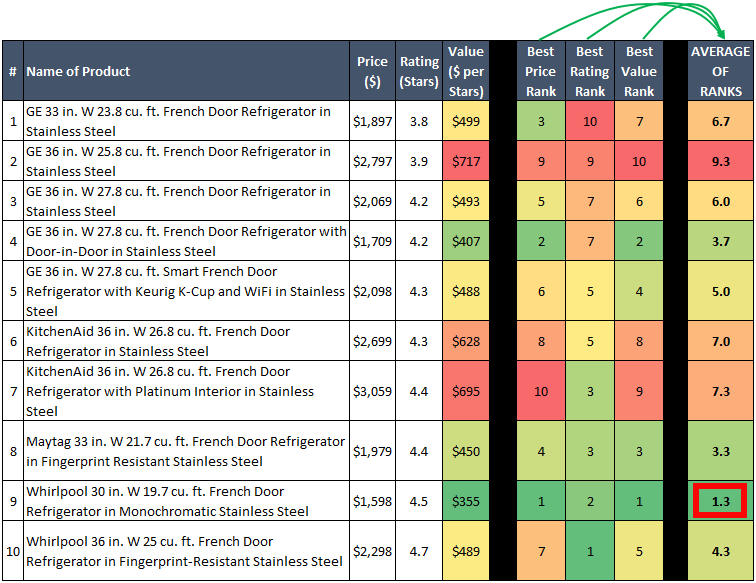
This information is huge. It quickly shows which product—in this case, Fridge #9—is best when taking price, rating, and value into account. That’s what you need!
Moreover, you can quickly get a sense of how much better it would be to buy Fridge #9 as compared with any other refrigerator. I say that because while Fridge #9 earns an average rank of 1.3, the second-best refrigerator—Fridge #8—earns a rank of 3.3, which is 2.5x worse. (And you don’t really even need to do the math, because the color-coding makes it pretty clear that Fridge #9 is in a class of its own. You know, the “bright-green class”!)
If you didn’t grab the “Product Decision Tool” earlier, get it now. It will save you thousands of dollars over time:
Conclusion
Whenever you are deciding between two or more products with similar features, the question arises: should you buy the highest-rated regardless of cost? Or the cheapest regardless of quality?
I think we all know that both factors are important and that some sort of blend of those factors probably makes the most sense.
The tool I use to make such decisions should help you identify the best overall product. And do so quickly.
Over the course of a lifetime, buying products this way can save you a lot of money. You’ll avoid overpaying for highly-rated products that aren’t a good value. And you’ll also avoid purchasing cheap products that need to be repaired or replaced often. Instead, you’ll tend to get modestly-priced, very good quality products that last a long time.
Question: When buying a product, which is more important to you: quality or price? You can leave a comment by clicking here.
If you liked this post, why not join the 5,000+ subscribers who receive blog updates on how to have more time and money for what matters most? Sign up here.

Thanks for the great tool! Trying to “un-scientifically” find an average of the best price and best rating in my head is rarely effective. This will go a long way toward putting my mind at ease when making a large purchase.
Awesome; thanks, DadOBoys!
Brian, thank you for your blog post.Really thank you! Awesome.
Thanks, Dekky; my pleasure.
Thanks a lot for the article post.Much thanks again. Fantastic.
Thank you very much, rkonline. Glad to be of help.